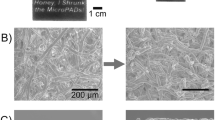Abstract
Three-dimensional microfluidic paper-based analytical devices (3D-μPADs) represent a promising platform technology that permits complex fluid manipulation, parallel sample distribution, high throughput, and multiplexed analytical tests. Conventional fabrication techniques of 3D-μPADs always involve stacking and assembling layers of patterned paper using adhesives, which are tedious and time-consuming. This paper reports a novel technique for fabricating 3D microfluidic channels in a single layer of cellulose paper, which greatly simplifies the fabrication process of 3D-μPADs. This technique, evolved from the popular wax-printing technique for paper channel patterning, is capable of controlling the penetration depth of melted wax, printed on both sides of a paper substrate, and thus forming multilayers of patterned channels in the substrate. We control two fabrication parameters, the density of printed wax (i.e., grayscale level of printing) and the heating time, to adjust the penetration depth of wax upon heating. Through double-sided printing of patterns at different grayscale levels and proper selection of the heating time, we construct up to four layers of channels in a 315.4-μm-thick sheet of paper. As a proof-of-concept demonstration, we fabricate a 3D-μPAD with three layers of channels from a paper substrate and demonstrate multiplexed enzymatic detection of three biomarkers (glucose, lactate, and uric acid). This technique is also compatible with the conventional fabrication techniques of 3D-μPADs, and can decrease the number of paper layers required for forming a 3D-μPAD and therefore make the device quality control easier. This technique holds a great potential to further popularize the use of 3D-μPADs and enhance the mass-production quality of these devices.






Similar content being viewed by others
References
Brooks T, Keevil CW (1997) A simple artificial urine for the growth of urinary pathogens. Lett Appl Microbiol 24(3):203–206. doi:10.1046/j.1472-765X.1997.00378.x
Carrilho E, Martinez AW, Whitesides GM (2009) Understanding wax printing: a simple micropatterning process for paper-based microfluidics. Anal Chem 81(16):7091–7095. doi:10.1021/Ac901071p
Ge L, Yan J, Song X, Yan M, Ge S, Yu J (2012a) Three-dimensional paper-based electrochemiluminescence immunodevice for multiplexed measurement of biomarkers and point-of-care testing. Biomaterials 33(4):1024–1031. doi:10.1016/j.biomaterials.2011.10.065
Ge S, Ge L, Yan M, Song X, Yu J, Huang J (2012b) A disposable paper-based electrochemical sensor with an addressable electrode array for cancer screening. Chem Commun 48(75):9397–9399. doi:10.1039/c2cc34887j
Lewis GG, DiTucci MJ, Baker MS, Phillips ST (2012) High throughput method for prototyping three-dimensional, paper-based microfluidic devices. Lab Chip 12(15):2630–2633. doi:10.1039/C2lc40331e
Li X, Tian J, Nguyen T, Shen W (2008) Paper-based microfluidic devices by plasma treatment. Anal Chem 80(23):9131–9134. doi:10.1021/ac801729t
Li X, Zwanenburg P, Liu XY (2013) Magnetic timing valves for fluid control in paper-based microfluidics. Lab Chip 13(13):2609–2614. doi:10.1039/C3LC00006K
Liu H, Xiang Y, Lu Y, Crooks RM (2012) Aptamer-based origami paper analytical device for electrochemical detection of adenosine. Angew Chem 51(28):6925–6928. doi:10.1002/anie.201202929
Lu Y, Shi WW, Jiang L, Qin JH, Lin BC (2009) Rapid prototyping of paper-based microfluidics with wax for low-cost, portable bioassay. Electrophoresis 30(9):1497–1500. doi:10.1002/elps.200800563
Lutz BR, Trinh P, Ball C, Fu E, Yager P (2011) Two-dimensional paper networks: programmable fluidic disconnects for multi-step processes in shaped paper. Lab Chip 11(24):4274–4278. doi:10.1039/c1lc20758j
Martinez AW, Phillips ST, Butte MJ, Whitesides GM (2007) Patterned paper as a platform for inexpensive, low-volume, portable bioassays. Angew Chem Int Ed 46(8):1318–1320. doi:10.1002/anie.200603817
Martinez AW, Phillips ST, Carrilho E, Thomas SW, Sindi H, Whitesides GM (2008a) Simple telemedicine for developing regions: camera phones and paper-based microfluidic devices for real-time, off-site diagnosis. Anal Chem 80(10):3699–3707. doi:10.1021/ac800112r
Martinez AW, Phillips ST, Whitesides GM (2008b) Three-dimensional microfluidic devices fabricated in layered paper and tape. Proc Natl Acad Sci USA 105(50):19606–19611. doi:10.1073/pnas.0810903105
Martinez AW, Phillips ST, Whitesides GM, Carrilho E (2010) Diagnostics for the developing world: microfluidic paper-based analytical devices. Anal Chem 82(1):3–10. doi:10.1021/ac9013989
Nie ZH, Deiss F, Liu XY, Akbulut O, Whitesides GM (2010) Integration of paper-based microfluidic devices with commercial electrochemical readers. Lab Chip 10(22):3163–3169. doi:10.1039/C0lc00237b
Noh H, Phillips ST (2010) Fluidic timers for time-dependent, point-of-care assays on paper. Anal Chem 82(19):8071–8078. doi:10.1021/Ac1005537
Ohta N, Rosen M (2006) Color desktop printer technology: optical science and engineering, vol 106. CRC Press/Taylor and Francis Group, Boca Raton, FL
Schilling KM, Lepore AL, Kurian JA, Martinez AW (2012) Fully enclosed microfluidic paper-based analytical devices. Anal Chem 84(3):1579–1585. doi:10.1021/ac202837s
Schilling KM, Jauregui D, Martinez AW (2013) Paper and toner three-dimensional fluidic devices: programming fluid flow to improve point-of-care diagnostics. Lab Chip 13(4):628–631. doi:10.1039/C2LC40984D
Washburn EW (1921) The dynamics of capillary flow. Phys Rev 17(3):273–283. doi:10.1103/PhysRev.17.273
Yetisen AK, Akram MS, Lowe CR (2013) Paper-based microfluidic point-of-care diagnostic devices. Lab Chip 13(12):2210–2251. doi:10.1039/c3lc50169h
Zhao C, Thuo MM, Liu XY (2013) A microfluidic paper-based electrochemical biosensor array for multiplexed detection of metabolic biomarkers. Sci Technol Adv Mater 14(5). doi:10.1088/1468-6996/14/5/054402
Zuo P, Li X, Dominguez DC, Ye B-C (2013) A PDMS/paper/glass hybrid microfluidic biochip integrated with aptamer-functionalized graphene oxide nano-biosensors for one-step multiplexed pathogen detection. Lab Chip 13(19):3921–3928. doi:10.1039/c3lc50654a
Acknowledgments
This work was supported by Natural Sciences and Engineering Research Council of Canada (NSERC), Canadian Foundation for Innovation, and McGill University. The authors also acknowledge financial supports from the Canadian Research Chairs Program (to Xinyu Liu) and the NSERC-CREATE Training Program in Integrated Sensor Systems (to Xiao Li).
Author information
Authors and Affiliations
Corresponding author
Electronic supplementary material
Below is the link to the electronic supplementary material.
Rights and permissions
About this article
Cite this article
Li, X., Liu, X. Fabrication of three-dimensional microfluidic channels in a single layer of cellulose paper. Microfluid Nanofluid 16, 819–827 (2014). https://doi.org/10.1007/s10404-014-1340-z
Received:
Accepted:
Published:
Issue Date:
DOI: https://doi.org/10.1007/s10404-014-1340-z




